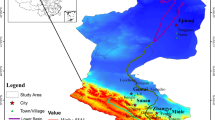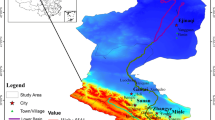Abstract
This study investigates the spatial distribution of economic benefits and costs of an ecological restoration project for an urban branch stream, namely Yeocheon-Cheon in Nam-Gu, Ulsan metropolitan city, South Korea. A contingent valuation method with the one and one-half bounded dichotomous choice model was applied, and a spike model was employed to address zero-WTP responses. First, benefits of the project were not limited to the project site jurisdiction (Nam-Gu) but extended to the whole metropolitan city. Second, the significant negative coefficient of the distance variable indicates the distance decay of WTP for the project. Third, respondents who visited the site showed a significantly higher willingness to pay for the project. Finally, the project was economically profitable and socially desirable from the benefit–cost perspective. However, the cost allocation between jurisdictions was fiscally nonequivalent in terms of the spatial benefit distribution.

Similar content being viewed by others
Notes
Local governments in South Korea have a two-tier system. Upper-tier authorities are metropolitan cities (Gwangyeok-Si) and provinces (Do). Lower-tier authorities are boroughs (Gu) and counties (Gun) of a metropolitan city, and cities (Si) and counties (Gun) of a province. National rivers are managed by upper-tier local governments, whereas local rivers are managed by lower-tier local governments.
According to Bateman et al. (2006), there are equivalent loss studies examining the value of preserving water quality, conservation areas, endangered species, wetlands, and remote mountain lakes. Such studies verify expectations of significant distance decay in the overall WTP value but not in present nonuser values.
Biases associated with the double-bounded dichotomous choice (DBDC) model have been tested using various hypotheses such as the persistent hypothesis, the anchoring hypothesis, the cost expectation hypothesis, the yes-saying hypothesis, and the framing hypothesis (Chien et al. 2005).
To prevent a negative or insignificant WTP value, protest zero bidders are generally dropped from the sample. However, this can bring about the loss of a valid number of observations. Therefore, Carson and Hanemann (2005) asserted that this practice of dropping is being gradually abandoned because of growing evidence that most protest zeros tend to resemble a “no” response.
KRW indicates the monetary unit in Korea, and one US dollar ($1) was about KRW 1100 during the analysis period.
References
Alberini A, Cropper M, Fu T, Krupnick A, Liu J-T, Shaw D, Harrington W (1997) Valuing health effects of air pollution in developing countries: the case of Taiwan. J Environ Econ Manag 34:107–126
Barreiro J, Sanchez M, Viladrich-Grau M (2005) How much are people willing to pay for silence? A contingent valuation study. Appl Econ 37:1233–1246
Bateman IJ, Langford IH, Jones AP, Kerr GN (2001) Bound and path effects in double and triple bounded dichotomous choice contingent valuation. Resour Energy Econ 23:191–213
Bateman IJ, Cooper P, Georgiou S, Navrud S, Poe GL, Ready RC, Reira P, Ryan M, Vossler CA (2005) Economic valuation of policies for managing acidity in remote mountain lakes: examining validity through scope sensitivity testing. Aquat Sci 67(3):274–291
Bateman IJ, Day BH, Georgiou S, Lake I (2006) The aggregation of environmental benefit values: welfare measures, distance decay and total WTP. Ecol Econ 60:450–460
Bohara AK, Kerkvliet J, Berrens RP (2001) Addressing negative willingness to pay in dichotomous choice contingent valuation. Environ Resour Econ 20(3):173–195
Boyle K, Welsh M, Bishop R (1993) The role of question order and respondent experience in contingent-valuation studies. J Environ Econ Manag 25:580–599
Burton A, Carson K, Chilton S, Hutchinson W (2003) An experimental investigation of explanations for inconsistencies in response to second offers in double referenda. J Environ Econ Manag 46:472–489
Cameron TA (1988) A new paradigm for valuing non-market goods using referendum data: maximum likelihood estimation by censored logistic regression. J Environ Econ Manag 15:355–379
Campbell D, Hutchinson WG, Scarpa R (2009) Using choice experiments to explore the spatial distribution of willingness to pay for rural landscape improvements. Environ Plan A 41:97–111
Carson RT, Groves T (2007) Incentive and informational properties of preference questions. Environ Resour Econ 37:181–210
Carson RT, Hanemann WM (2005) Contingent valuation. In: Mäler KG, Vincent JR (eds) Handbook of environmental economics: valuing environmental changes, vol 2. Elsevier, Amsterdam, pp 821–936
Carson RT, Flores N, Meade N (2001) Contingent valuation: controversies and evidence. Environ Resour Econ 19:173–210
Chien Y-L, Huanf CJ, Shaw D (2005) A general model of starting point bias in double-bounded dichotomous contingent valuation survey. J Environ Econ Manag 50:362–377
Choi A (2013) Nonmarket values of major resources in the Korean DMZ areas: a test of distance decay. Ecol Econ 88:97–107
Coneu GB (2007) Investigating distance effects on environmental values: a choice modeling approach. Aust J Agric Resour Econ 51:175–194
Cooper JC, Signorello G (2002) One and one-half bound dichotomous choice contingent valuation. Rev Econ Stat 84:742–750
Cooper JC, Hanemann WM (1994) Referendum contingent valuation: how many bounds are enough? USDA economic research search service. Food and consumer economics division. In: Working Paper
Eusepi G (2000) Contractual fiscal equivalence versus geographical fiscal equivalence. Public Choice 104:309–317
Haab TC, McConnell KE (1997) Referendum models and negative willingness to pay: alternative solution. J Environ Econ Manag 32:251–270
Hanemann WM (1984) Welfare evaluations in contingent valuation experiments with discrete response. Am J Agric Econ 66:332–341
Hanemann WM (2012) Issues in the design and analysis of valuation data. In: International symposium on CVM guideline for PFS. 2012. 5. 17. KDI main conference hall
Hanley N, Schläpfer F, Spurgeon J (2003) Aggregating the benefits of environmental improvements: distance-decay functions for use and non-use values. J Environ Manag 68:297–304
Hwang J, Yoo SH (2012) Measuring the economic benefits of establishing Bukhansan Dullegil. J Korean Reg Sci Assoc 28(3):141–160
Johnston RJ, Duke JM (2009) Willingness to pay for land preservation across states and jurisdictional scale: implications for benefit transfer. Land Econ 85(2):217–237
Kim J, Park J, Kim H, Heo E (2012) Assessment of Korean customers’ willingness to pay with RPS. Renew Sustain Energy Rev 16:695–703
KOSIS (the Korean Statistical Information Service). www.kosis.kr
Krinsky I, Robb AI (1986) On approximating the statistical properties of elasticities. Rev Econ Stat 72:189–190
Krinsky I, Robb AI (1990) On approximating the statistical properties of elasticities: correction. Rev Econ Stat 68:713–719
Kriström B (1997) Spike models in contingent valuation. Am J Agric Econ 79(3):1013–1023
Kwon O, Shin Y, Yoo SH (2012) KDI PFS guidelines and estimation of WTP with CV survey data. In: International symposium on CVM guideline for PFS. 2012. 5. 17. KDI Main conference hall
Lee JS, Yoo SH (2011) Willingness to pay for GMO labeling policies: the case of Korea. J Food Saf 31(2):160–168
Loomis JB (1996) How large is the extent of the market for public goods: evidence from a nationwide contingent valuation survey. Appl Econ 28:779–782
Loomis JB (2000) Vertical summing public good demand curves: an empirical comparison of economic versus political jurisdictions. Land Econ 76(2):312–321
McConnell KE (1990) Models for referendum data: the structure of discrete choice models for contingent valuation. J Environ Econ Manag 18(1):19–34
National Oceanographic and Atmospheric Administration (NOAA) (1993) Natural resource damage assessments under the Oil Pollution Act of 1990. Fed Reg 58(10):4601–4614
Olson M Jr (1969) The principle of fiscal equivalence: the division of responsibilities among different levels of government. Am Econ Rev 59(2):479–487
Pate J, Loomis J (1997) The effect of distance on willingness to pay values: a case study of wetlands and salmon in California. Ecol Econ 20:199–207
Plummer M (2009) Assessing benefit transfer for the valuation of ecosystem services. Front Ecol Environ 7:38–45
Rolfe J, Windle J (2012) Distance decay functions for iconic assets: assessing national values to protect the health of the Great Barrier Reef. Environ Resour Econ 53(3):347–365
Salazar S, Menéndez LG (2007) Estimating the non-market benefits of an urban park: Does proximity matter? Land Use Policy 24:296–305
Sutherland RJ, Walsh RG (1985) Effect of distance on the preservation value of water quality. Land Econ 61(3):281–291
Tait P, Baskaran R, Cullen R, Bicknell K (2012) Nonmarket valuation of water quality: addressing spatially heterogeneous preferences using GIS and a random parameter logit model. Ecol Econ 75:15–21
Taylor G, Mckean J, Johnson D (2010) Measuring the location value of a recreational site. J Agric Resour Econ 35:87–104
Yoo SH (2007) Using one and one-half bounded dichotomous choice model to measure the economic benefits of urban noise reduction. Environ Resour Econ Rev 16(3):451–483
Acknowledgments
This study was supported by the UOU Research Fund in 2014, and we are grateful to the two anonymous referees for their valuable comments.
Author information
Authors and Affiliations
Corresponding author
Additional information
Jae Hong Kim is first author.
Appendix
Appendix
See Table 10.
Rights and permissions
About this article
Cite this article
Kim, J.H., Kim, SN. & Doh, S. The distance decay of willingness to pay and the spatial distribution of benefits and costs for the ecological restoration of an urban branch stream in Ulsan, South Korea. Ann Reg Sci 54, 835–853 (2015). https://doi.org/10.1007/s00168-015-0688-7
Received:
Accepted:
Published:
Issue Date:
DOI: https://doi.org/10.1007/s00168-015-0688-7




